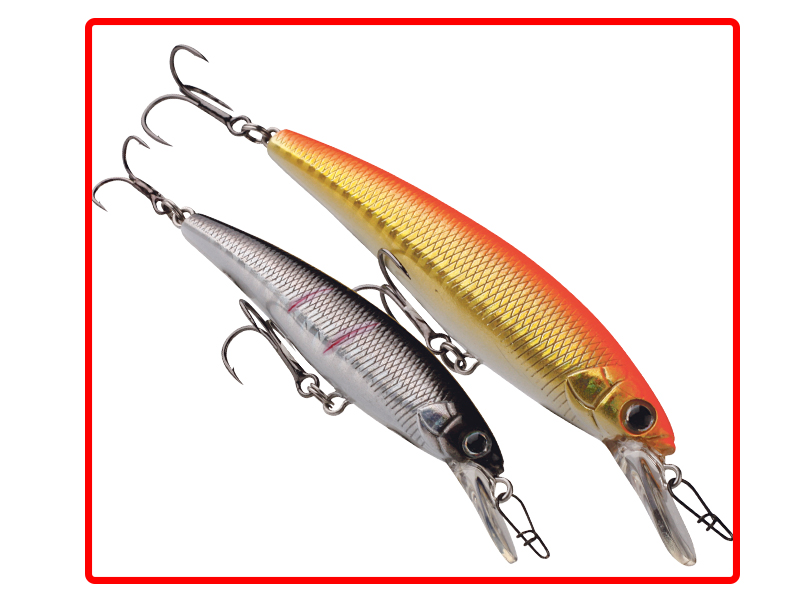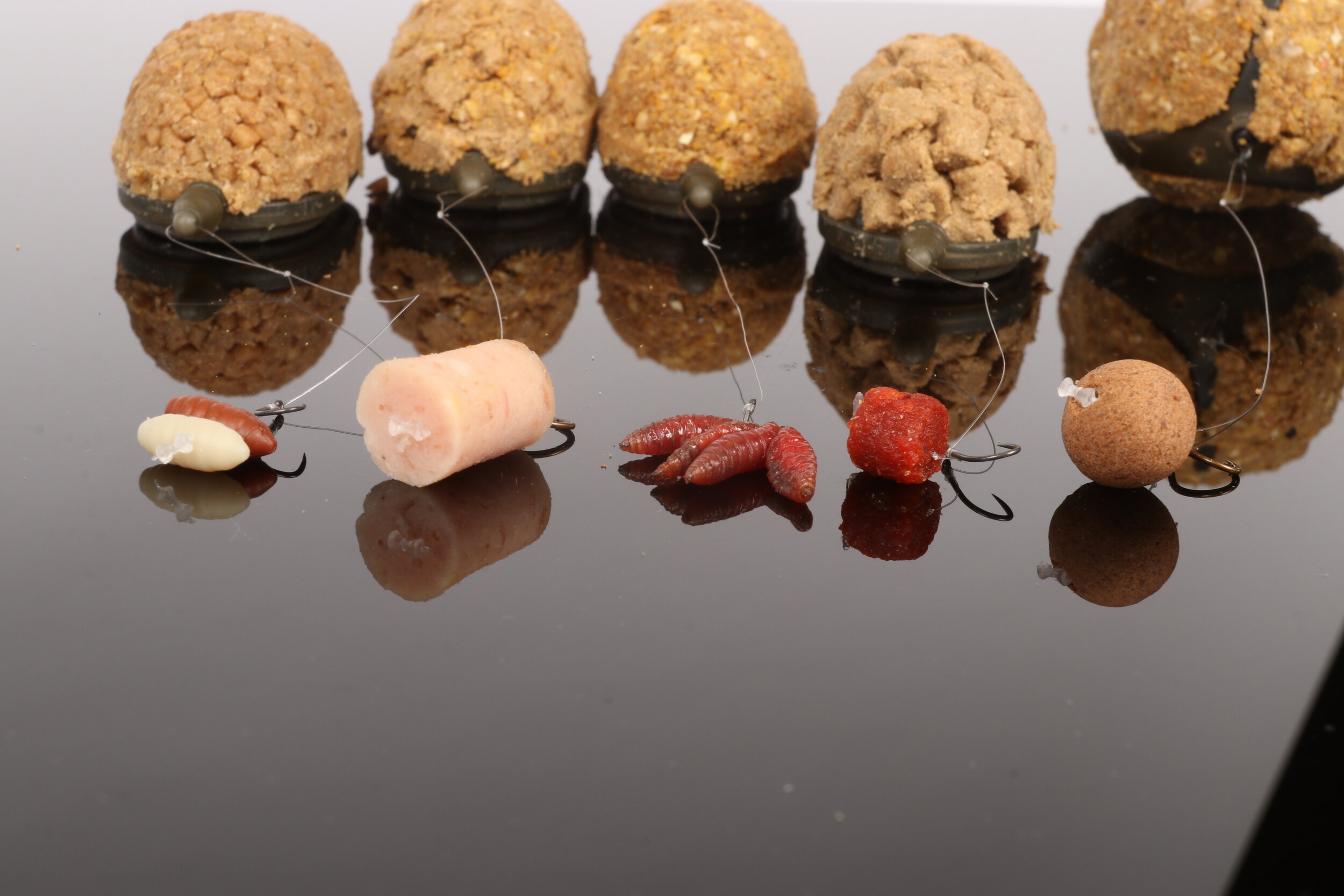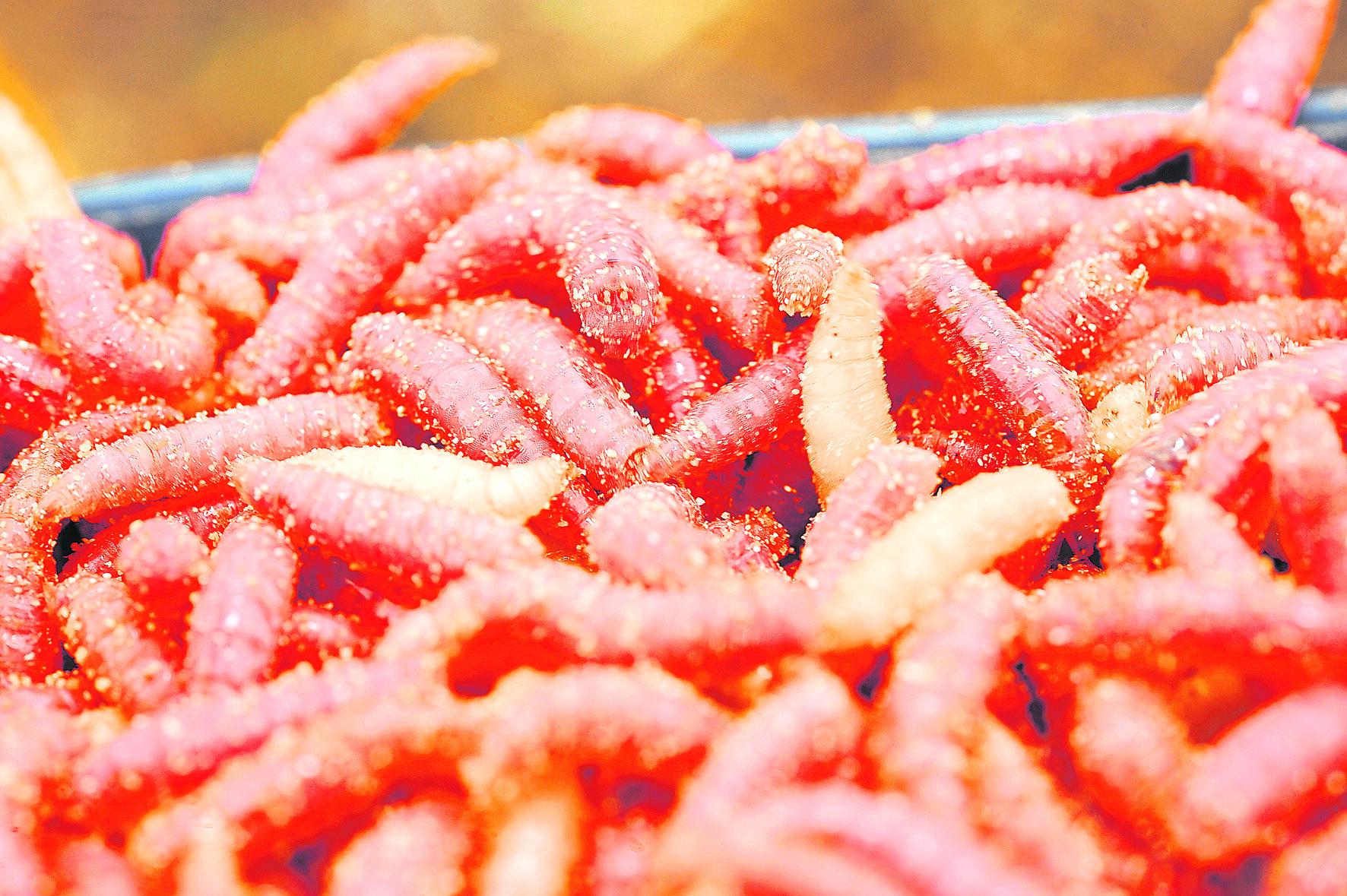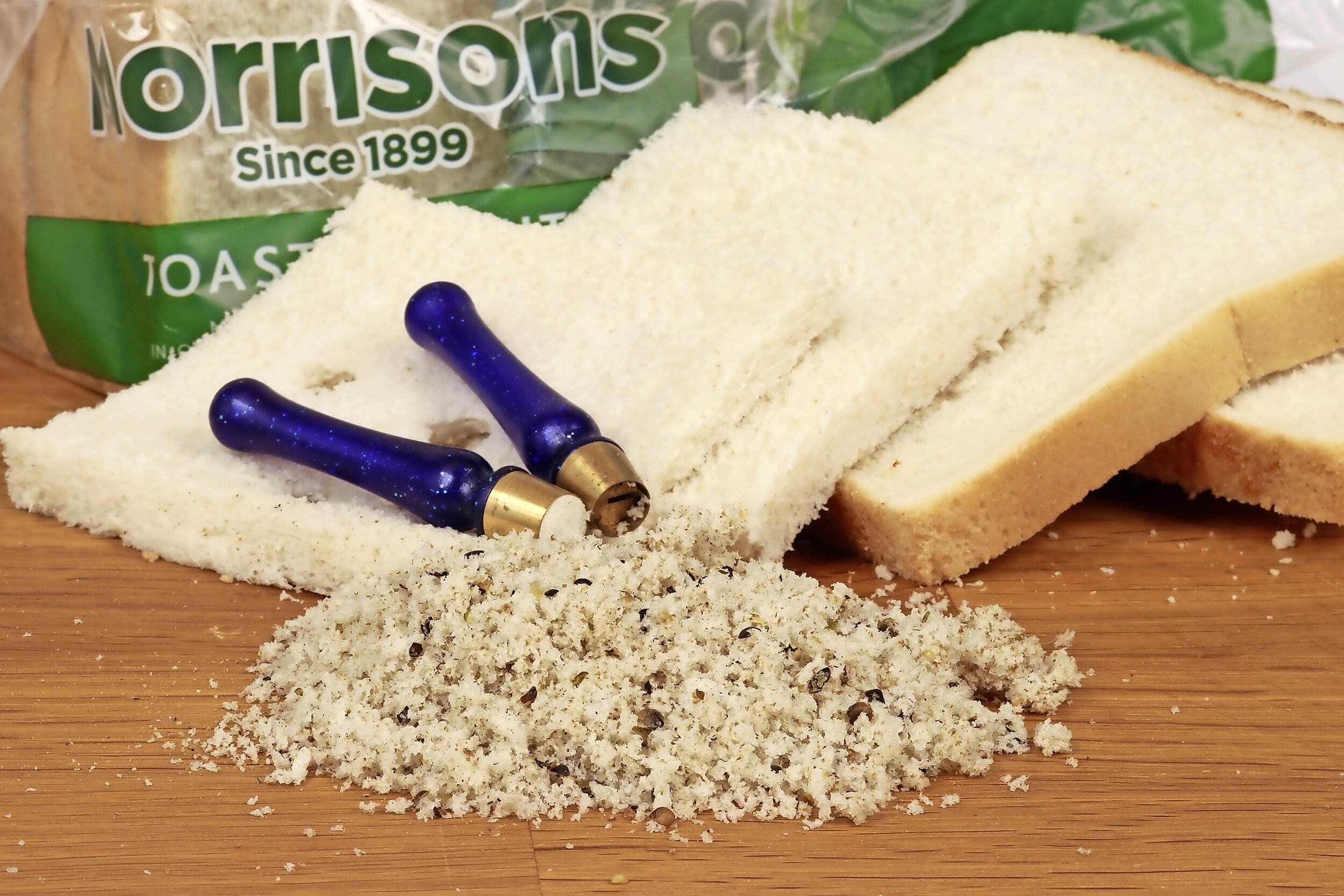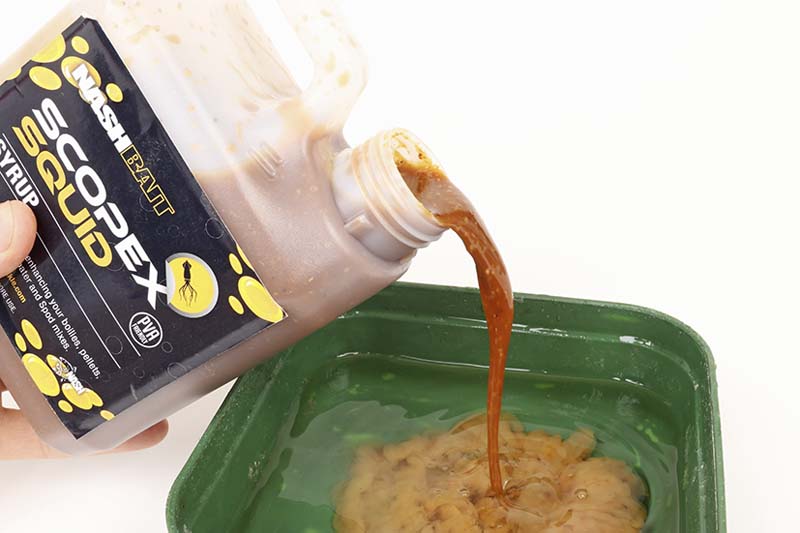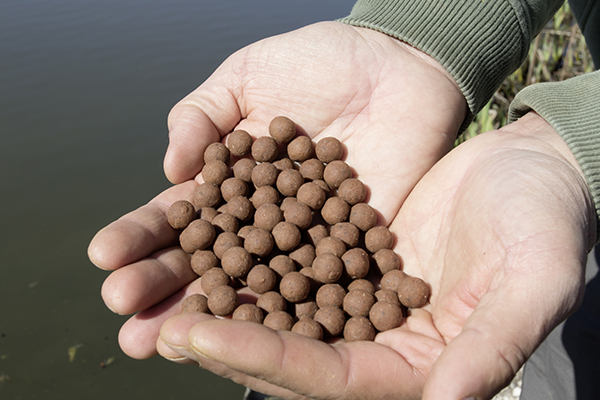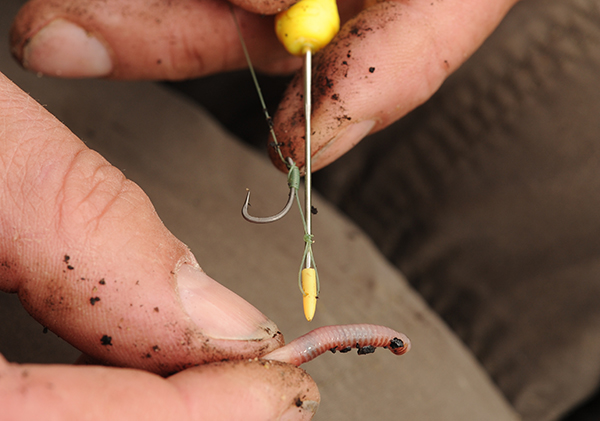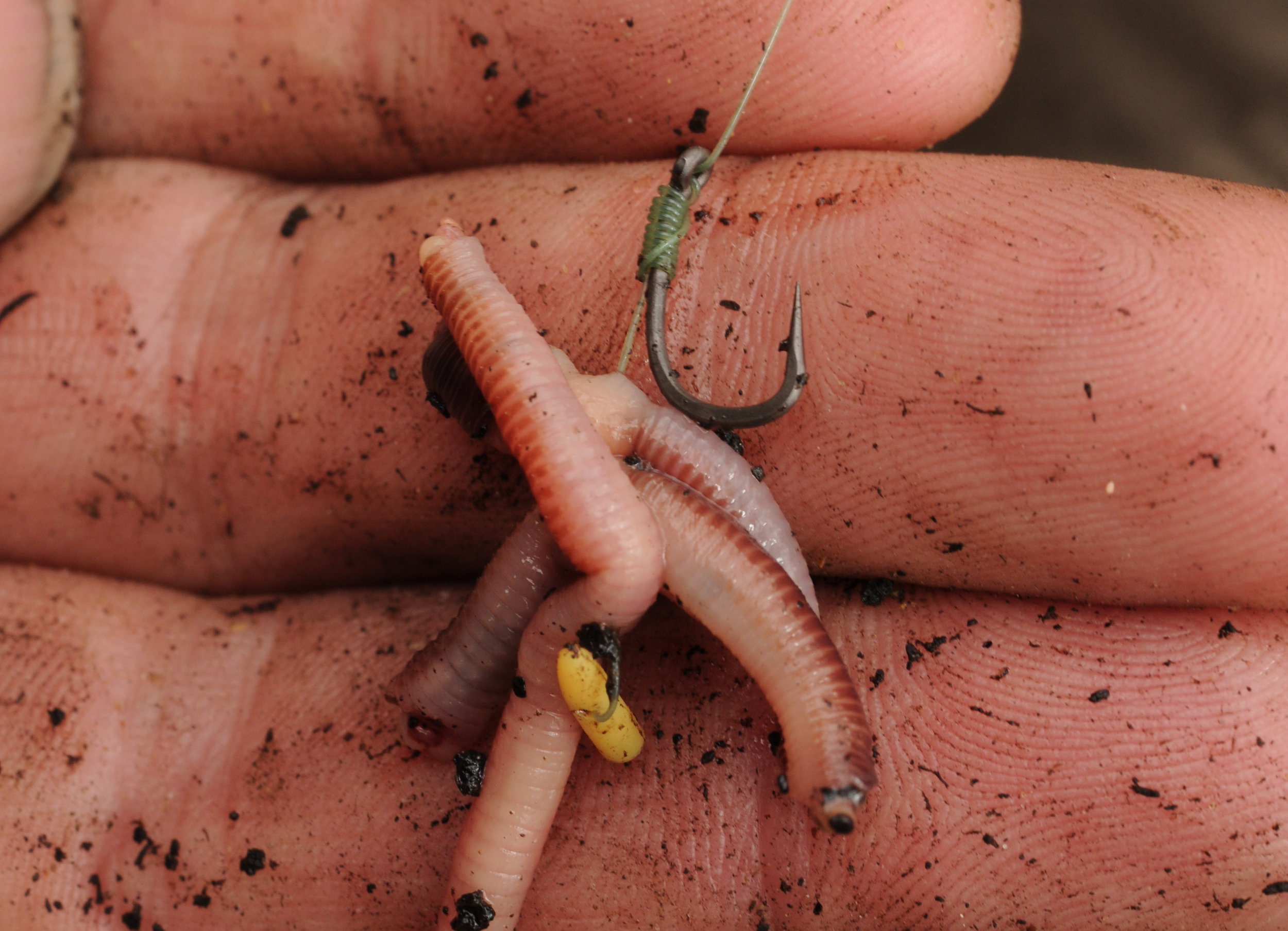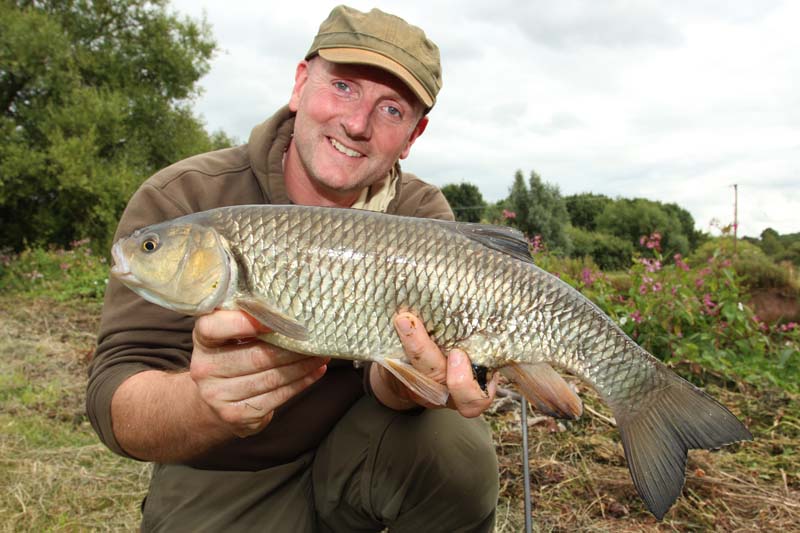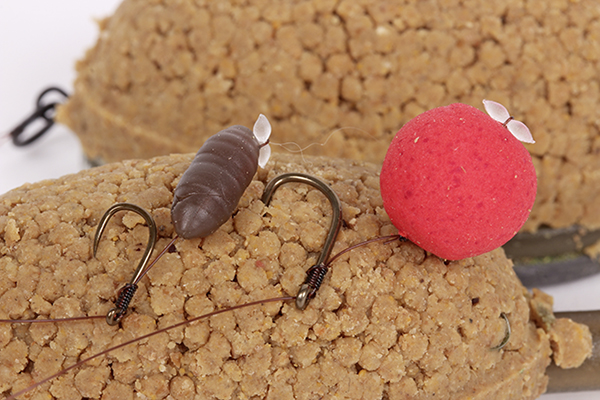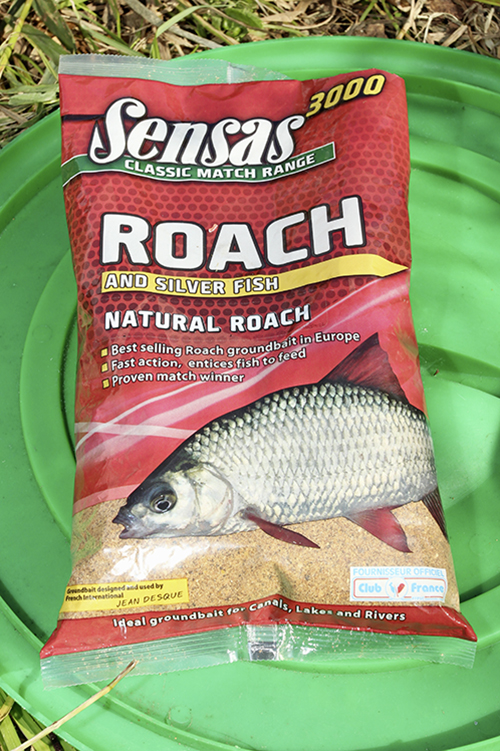How to make doughy cheesepaste with Paul Garner
Even when the water is really cold, Doughy cheesepaste stays pliable, making this my favourite recipe. A batch will last several weeks if you keep it cool between trips. Here is how to make it…
1: Carefully melt some blue cheese in a microwave set on half power for about 30 seconds.
2: Knead a fist-sized lump of dough until it has warmed up and softened.
3: Flatten the dough out and then spread the melted blue cheese on to it.
4: Sprinkle on a teaspoonful of Squid Powder and a tablespoonful of Parmesan.
5: Fold the paste in half and work it for five minutes until everything is evenly mixed.
Make it buoyant
1: With a bait drill bore a hole through a small piece of cork (wine bottle corks work fine)
2: Superglue the drilled cork to the shank of your hook, leaving the point well clear.
3: Fold a piece of cheesepaste over the hook and cork, covering them completely.
4: The finished bait – you can strike straight through it when a chub takes a bite.
For more great bait tips from Dr Paul Garner, pick up the magazine each Tuesday!
Boost your groundbait and catch more river bream
At this time of year, even a single day of rain is enough to send river levels up and add colour to the water. When that happens, bream become a reliable target.
Spurred into feeding by this influx of water and reduced visibility, these fish can appear after months of absence. In mild weather, 100lb is possible when you land on a hungry shoal on slow-flowing venues – but it’s far from a case of simply throwing a feeder out and bagging!
We asked England international and former FeederMasters champ Darren Cox for his tips on river bream succes in these conditions.
Choose your peg
“The first consideration is where in the peg to fish. I look for any large areas of slack water, whether thaey are caused by a bay or water running off a bend.
“The point where a river opens out from narrows is another guaranteed bream area. They love slower water, as not only is there reduced pace but natural food and silt will gather, resulting in a big larder for them to get stuck into.
“The silt will be full of bloodworm and the bream won’t move far from here. To find a silty bottom, cast a feeder or bomb out and wind it slowly back across the river bed. Resistance as the lead digs into the silt tells you you’ve found what you’re looking for.”
Add some fishmeal
“With colour in the water, bream feed by scent, not sight, so a groundbait to go in the feeder needs something powerful to stop them – that means fishmeal. I’ll mix up a ‘normal’ bream blend of sweet groundbait but also add a good helping of a halibut or plain pellet-based mix. This is mixed fairly dry to empty out quickly.”
Feed and hookbaits
“Keeping with the positive theme, I try and cram each feederful with as many particles as I can. That’s casters, chopped worm and dead maggots lacing the groundbait, because a big bream can demolish a feeder of bait in one go. Imagine this happening with a dozen fish in the area and you can see how much feed needs to go in.
“For the hook, nothing can beat worms on a coloured river, and while a dendra or lobworm tail is good, I swear by two large redworms tipped with a dead red maggot. Redworms wriggle like mad, and a bream can pick them out far quicker than three dead maggots, for example.”
Keep the bait going in
“I’ll cast every five minutes, even if I’m not getting bites to keep the bait going in on a regular basis – you have to be positive. Clipping up and aiming to a far-bank marker will put the feeder in the right place each time.
“If I cast and immediately get a knock on the tip this tells me that the fish are not backing off and that they want the feed, so you need to try and read the timing of the bite. If I am left waiting five minutes for an indication then the fish could be backing off.”
The feeder is king
“Rod and line is the only option for tackling a slack at range – the waggler just won’t present the bait still enough. That means it’ll be an out-and-out feeder job. Rigs for a slow river are nothing special, made up of the feeder running on the mainline that has a short 4ins twizzled length above the hooklink, for a semi-bolt rig effect.
“Mainline of 6lb is perfect, with a 30g wire cage feeder heavy enough to hold bottom in the slower water. A hooklink of 2ft 6ins or 3ft made up of 0.16mm Garbo Line will put the bait well downstream of the feeder, which is where you often find bigger bream sat below the feed picking off particles. That only leaves the hook to pick, and I can’t fault a size 13 Kamasan B711.”
Kicking off
“Six feeders of bait go in at the start and I would expect indications quickly. If nothing happens after half-an-hour but I am getting small fish knocks, this tells me more bait needs to go in so out go another six feederfuls.
“If nothing is happening at all then it will be a bit of a waiting game so you’ll need to leave the feeder out for longer and wait. Provided you are on a bream peg and conditions are right, there’s no reason why they won’t feed.”
Top Five Roach fishing baits to try now!
What is the best bait to use when roach fishing? Well we are about to answer that for you and give you five great roach fishing bait options for you to try next time you’re on the bank.
Here are five of the best roach fishing baits…
For more great tips from top anglers head to this year’s The Big One Show
• Maggots
I have often noticed that smaller silver fish tend to become a lot less active at this time of year, owing to the low water temperature, while the larger fish remain active. This can make maggots a viable bait.
Ask your local tackle shop on what day they receive their maggot supplies, and try to buy your bait as soon as it comes in. This will ensure you get the freshest and largest maggots. To keep the skins soft I store them in maize flour, changed every few days to keep it fresh.
Pineapple essence is the quintessential winter roach flavour, and its highly volatile esters leak off even when the water is very cold. Other citrus flavours are well worth using too, but there’s no substitute for fresh bait, especially where big winter roach are concerned.
• Pellets
Our barbel rivers see large amounts of pellets going in all summer and autumn, and naturally roach tune in to this extra food resource. Fishmeal is a good fish attractor, even though we don’t normally associate it with roach. Try mixing some ground pellets with your liquidised bread and you’ll see what I mean.
For roach, try scaling everything right down to a 6mm tough hooker pellet fished on a bait spike and size 16 hook. Fill a Black Cap feeder with hemp and hard pellets. Don’t worry about the water temperature – roach will still eat pellets in the depths of winter, so I plan to use this tactic a lot this year.
• Hemp
When I have filmed roach underwater no other bait has attracted and held them in the swim like hemp, yet they often pick it up and blow it out many times before eating it.
For this reason I tend to feed the seed sparingly. A tin of hemp is generally enough for a day session. Feed it a pinch at a time to maintain a continual release of hemp flavour into the swim, rather than have it slowly dwindle away.
I don’t often fish hemp on the hook, but I will combine it with my other four baits. Hemp and pellet is a modern classic, in my book, and well worth trying, especially on barbel rivers.
• Boilies
As with pellets and hemp, roach see a lot of boilies as a by-product of carp and barbel anglers’ feed. Some of the biggest winter roach are caught by carp anglers on boilies, and this is a very effective way of singling out the bigger fish.
A 10mm boilie is just about the right size for a 2lb roach, and I can think of a number of times that this bait, along with a small PVA stick of pellets, has allowed me to get through the small fish and select just the big ones from the shoal.
• Bread
There is no better bait for roach than bread. Very cheap, it selected big fish from rivers and lakes where we never dreamed the roach grew so large. Knowledge of how to get the best from bread is slowly ebbing away, but that doesn’t make it any less effective, just unfashionable.
Back in the day I’d use heavy trotting gear with an 8mm disc of punched bread on the hook. A nugget of liquidised bread fed every cast would be all the feed that was required.
I am sure these tactics would still work just as well today and I plan to try them again soon, especially on running waters, where a bright, obvious bait would be difficult for any big roach to ignore.
Best baits to use to catch big perch
With the cold weather upon us it is time to start thinking about big perch and what baits to use when trying to lure a a PB into your net. We have taken a look at the best baits to be using right now when it comes to catching big perch.
For more great tips from top anglers head to this year’s The Big One Show
Worms
Few perch can resist a worm, with big lobworms picking out the specimens, while smaller redworms will catch smaller fish when the going is tough.
Lures
Perch will always chase a lure around, and small spoons and spinners take their share of fish – just be sure to use a wire trace in case of pike.
Livebaits
If fishery rules allow, a small live roach or minnow fished under a loafer-style float will produce, fished close to ambush spots.
Prawns
Commercial fishery perch seem especially fond of a tiger prawn fished on the float or sometimes freelined at close range.
CRUNCHY CRUSTACEANS
Signal crayfish are a scourge, but where you find these invasive crustaceans you also find big perch.
You can mimic crays with a raw peeled prawn, even on venues that do not hold crayfish. You don’t need very many prawns for a days fishing – I cut each one in half for a more manageable bait. Even so, a size 8 hook is required to match the bait size.
I never feed whole prawns, as they are very filling. On a cold day a perch might only need one to fill it up. Instead, I recycle used hookbaits by finely dicing them with scissors and feeding this ‘mush’ a little at a time.
If you are roving around and fishing several swims, a good tactic can be to introduce a bit of bait into the next swim before fishing it. Don’t go mad – a single mashed-up prawn or two chopped worms will be plenty to get the perch looking for more without overfeeding them.
Worms
I’VE yet to find a better bait for perch than the humble worm. The only problem is that they can be too good, and on venues with a lot of other fish it can be impossible to get through to the perch. On rivers in particular, though, worms reign supreme. Dendrobaenas are good, but there’s no denying that a lobworm is better by far.
With this year’s dry summer collecting lobworms has been difficult, but fortunately you can buy them easily, either from your local tackle shop or via mail order.
Lobworms are not a cheap bait, but as with prawns you don’t need many for a perch session. I will feed dendrobaenas and save the lobs for the hook to keep the price down, often using half a worm as a hookbait.
If I am floatfishing or planning on recasting a leger regularly I will simply hook the worm once through the saddle. The odd one will wriggle free, but this can be solved by hooking a maggot on after the worm to secure it.
When I expect the baits to be left out for longer, I will switch to a hair-rigged worm, using two Quick Stops to hold it on the hair.
This is a very effective presentation that allows the hook to be scaled down to a size 12 and gives very easy-to-hit bites, as the perch tend to hook themselves.
Attraction
Big perch will often be found in small groups, and it is important not to introduce too much bait. I am sure that on occasion my chances have been ruined when I have given the fish a few mouthfuls of food, which has been enough to satisfy their hunger.
Rather than try to attract the perch these days I focus on attracting their prey, especially on commercial fisheries, where small silver fish are top of their menu. A regular sprinkling of maggots will attract small roach, which in turn will get the perch active. In clear water try adding a small amount of groundbait too, as this will pull in more small fish.
Big perch really are a sight to behold, particularly on a frosty morning. I bet you can think of a few venues close to home that hold some nice fish, so what’s stopping you?
With just the simplest of tactics and a few well-chosen baits you could soon be putting the net under a plump stripey.
STORING LOBWORMS
Lobworms aren’t cheap or that easy to collect at this time of year, so it pays to look after them well.
Use a large bait tub with holes in the lid and add plenty of damp leafmould, some shredded newspaper and a little soil. Store the tub out of the sun in a cool but not freezing spot, and change the mix every week to keep the worms alive for several months.
Best lures for pike fishing
With predator season upon us it’s time to dust off your lure box and get back out there. To help you choose the right lures for you next pike fishing session we have gone to our weekly columnist Paul Garner to get his opinion on what lures you should be taking out on your next session.
Lure fishing is exploding in the UK right now, as many anglers discover the joys of casting artificial baits for a wide range of predatory fish.
On my local canal you are now likely to find just as many anglers drop shotting for perch with small lures as you are fishing the pole.
Head to the coast, and piers and jetties are frequented by anglers targeting a myriad of different marine species with their LRF (Light Rock Fishing) gear, armed to the teeth with soft plastics.
All fish are predatory to some degree and I have seen bream, barbel and even dace caught fair and square on small lures, so there really is something for everyone.
For me, though, nothing beats fishing for big pike with lures and that electric feeling that signals a ‘hit’ from a big predator just can’t be beaten.
CHEAP AND RELIABLE
I am an avid collector of lures, but increasingly I find soft plastics dominating my tackle box.
These deceptively simple rubber fish-shaped baits come in a wide range of different outlines and sizes, but they all work in much the same way.
You can buy soft plastics either pre-rigged, or as bare lures that enable you to rig them just the way you like. Best of all, they are among the cheapest lures you can buy, making this a great way to get into lure fishing for pike.
Pre-rigged lures are the ideal place to start, as these will be rigged for optimal performance.
Once you have learnt how to use these, swap over to rigging your own so you are able to fine-tune your presentation. Go for lures in the 6ins/16cm range, as these will be the easiest to cast and will catch pike of all sizes.
SLOW AND STEADY
There is absolutely no need for any complicated retrieves with soft plastics. You simply let them sink to the desired depth and reel them in! The odd pause to let the lure sink back down will also often bring a bite, as the change in speed triggers a pike that is following the lure to take it – but ‘slow and steady’ is my mantra.
To keep the lure working in the right depth zone use one gram of weight per foot of depth.
So, on rivers and canals I use 5g lures, on lakes around 10g, and on deep reservoirs anything up to 30g.
A really useful skill to practise is counting the lure down until it hits the bottom, which you can feel as a distinct bump.
Once you know how long it takes for the lure to reach the deck, you can count it down to any depth you want very easily.
Try to mix up the depths that you are fishing at. Some days the pike will prefer a lure presented just beneath the surface, while on others they want it right on the bottom.
These simple soft plastics really are very effective, and will catch plenty of zander and big perch as well as pike if you scale down the size a little.
Why not give these popular lures a go this autumn?
How to prepare sticky micro pellets
Micro pellets need to be prepared quite differently to normal fishery pellets. Instead of soaking them it is much better to very slowly add water directly to the pellets, just as you would if mixing groundbait. This stops them breaking down and turning into concrete!
For more great tips from top anglers head to this year’s The Big One Show
1) Add a good glug of Scopex Squid Syrup to a pint of water and stir well until the syrup has dispersed.
2) Mix a handful of 3mm pellets with a bagful of sticky micro pellets and put the pellets into a shallow mixing bowl.
3) Slowly add the liquid while keeping the pellets moving all the time. Only add more water once the initial liquid has been absorbed.
4) When the pellets have reached the right consistency they should stick together when compressed in your hand, but break down to a mush when rubbed.
Spend less and catch more with this method mix!
Want to catch more carp while fishing? then take a look at this amazing carp fishing method mix from Angling Times columnist and Nash backed Paul Garner. We asked Paul to give us his best carp fishing bait on a budget and he came back with this golden piece of information.
Rather than use a Method mix that breaks down quickly, I much prefer a slower release of bait from the open frame of the flatbed feeder.
This ensures that the the bait on the feeder will remain the focus for the carp even when their frantic grubbing around on the bottom, complete with waving tails, is washing the pellets all over the swim.
To get this slower release effect is simple – I mix a small amount of groundbait in with the soaked pellets, as here...
1) Cover a pint of 4mm coarse fishery pellets with water and let them stand for four minutes to absorb some of the water.
Pour off the excess water and allow the pellets to stand for a few minutes more until they are soft all the way through.
Add just a sprinkling of Method groundbait to the pellets and mix well so that the dry groundbait evenly coats the pellets.
Use a Method mould to firmly press the pellets on to the feeder in the usual manner.
Leave the hookbait just outside the feeder so that it is not obstructed by the pellet feed.
The best bream fishing bait mix
Two-time Drennan Cup winner Dai Gribble reveals what his favourite bream fishing spod mix is. Take a look at the four steps below and try it out for yourself next time you're out on the bank bream fishing.
1) My feed is made up of a mixture of Sonubaits fishmeal and bread-based groundbaits. I will use Supercrush Bream Feeder as a base for the mix but will darken this off with Super Crumb Black Bream. You can make the mix even stickier by adding Super Crumb River to it, and this helps when you’re making long casts on the Method feeder.
2) The groundbaits are blended together first and then are mixed up with lots – up to a pint – of liquid molasses. Molasses is quite dense and very soluble, and a trail of it will leak off the groundbait in the undertow, pulling bream from a long distance.
3) The crumb is supplemented by a mix of Pro Feed and S-Pellet Feed Pellets in 2mm and 4mm sizes – great for keeping fish in the swim for longer – plus a couple of tins of F1 sweetcorn.
4) I also add a small number of the boilies that I use for hookbaits. The critical thing is not to introduce too many of the high-attract baits as free offerings. You want enough for the bream to get a taste for them and hunt them out, but not so many that it reduces the chances of them taking your hookbait.
Generally, I add no more than about 30 boilies, whilst using up to five kilograms of groundbait and pellets.
The best hookbait to use when fishing.
Paul Garner explains what his favourite hookbait is and what makes it so perfect.
What makes the perfect hookbait? Mine would need to have the right texture, breakdown speed and buoyancy. It would be easy to hook, of a perfect flavour and colour, and I’d want to be able to change the size and shape quickly.
That’s a big ask, and most baits fall down on one or more counts, yet I’ve been using one that fits the bill perfectly for two years.
Initially developed for fishing the Method for crucians, my set gel baits have become firm favourites and have caught me loads of different species, from carp and tench to chub and barbel.
The beauty of these baits is their versatility. Easy to make, they can be adapted to suit almost any situation and can be used with a huge range of additives for true customisation.
Gels are long-lasting in water, staying intact for several hours. The outside becomes almost slimy as it absorbs water and begins to break down, creating a lovely flavour trail.
I do believe that fish generally prefer softer baits, and gels offer the perfect compromise between a soft outer skin and a rubbery structure.
WHAT IS IT?
The secret to making my gel baits is a product known as Vege-Gel that you can buy from most supermarkets.
I came across this gelatine substitute when first playing around with set baits, and after some experimentation I found that it worked perfectly. The active ingredients are natural gelling agents that set when heated. Vege-Gel is used in baking, but by increasing the concentration it sets to make the perfect hookbait. Better still, just about any liquid or fine powder can be added to give it a distinctive flavour.
PURE AND SIMPLE
Making gel hookbaits is very easy if you follow my method. On its own the gel has virtually no taste and a clear colour, so it takes dyes and flavours very well.
In fact, if you want a really bright bait, adding half-a-teaspoonful of powdered dye will give you an incredibly vivid colour.
The same applies with liquid flavours and additives. The bland base means that the flavour really comes through. Keep levels very low, though, as it is very easy to overdo the flavour level.
I normally stick to about half the manufacturer’s recommended level. Food dips and liquid foods, which are not so concentrated, are ideal for these baits, giving more margin for error and a much rounder flavour to the bait.
GROUNDBAIT HOOKBAITS
You are not limited to just liquid additives in gels. Powders such as krill, squid and liver can be added – and what about groundbaits?
Imagine being able to use a hookbait that has exactly the same smell as the groundbait that you are introducing! All you need to do is add a handful of dry groundbait to the gel liquid and you will produce baits with the same flavour and colour as the feed. This has proved a useful tactic when fishing groundbait on the Method feeder for bream, as the fish just hoover up the whole lot without even noticing the hookbait amid the crumb.
MICRO-MIX
Another gel technique that I have been trying out is hookbaits incorporating micro pellets.
Initially, I ground the pellets down to a fine powder before mixing them into the bait, but although this worked well, it was time-consuming. Eventually, I tried adding tiny 1mm-2mm micros, and they worked a treat!
Once again, the finished bait perfectly matched the feed, giving me a really distinctive hookbait.
The bottom line is that you can use just about any additives you like to gel baits, and by altering the amount of water added go from a super-soft to a firm finished bait that can be tailored to the style of fishing that you are doing.
Recently I have been using larger baits to target bigger carp, and this has been very successful too.
For bigger fish I make the slab of bait slightly thicker, and once it has fully cooled I cut it into cubes and fish it just like luncheon meat.
My results have been excellent, so why not give it a go?
Dai Gribble's Worm kebab for Tench
Tench are now on the feed and one of the best baits for catching this incredible spring species is worm. We've asked two time Drennan Cup champ to show us his favourite way to rig worms when fishing for tench.
ONE-INCH WORMS
Start by chopping a few worms into inch-long sections and begin threading them on to the hair using a Quick Stop and needle. Dendrobaena worms are best for this.
GO LARGE
I use four sections of worm on a size 10 hook and three on a size 12 – the bigger the hook, the bigger the bait you can use.
MIND THE GAP
It’s important to tie your hairs long enough to leave a little gap between the top of the chopped worm and the bottom of the hook. This gives the bait more movement and leads to better hookholds.
CHOPPED WORM
You’re looking to put a lot of flavour into your feeder, and the best way of doing this is with chopped worm. Don’t turn the worms into a complete mush, though – 1cm long sections are ideal.
FILLING THE FEEDER
I buy my worms supplied in the peat they’re grown on in, as this is packed with attractants too. Start by half-filling the feeder with chopped worms and then add the peat, which I pack tightly into the feeder with my fingers.
ADD LIVE MAGGOTS
Always add a few live maggots to your feeder because these will help to push some of the flavour out when the rig is in the water. You actually want the mix to stay in the feeder as long as possible, creating a big ball of fish-attracting smell. It should only get flushed out when you reel in.
Best carp fishing groundbait mix
A simple fishmeal-based mix will catch plenty of carp, but I do like to add a couple of proven additives and a handful of larger feed items to keep the fish grubbing around. This is a great mix of mine to get you started, but the choice of ingredients really is endless.
The base mix is ground pellet groundbait specifically for Method fishing, as this will bind very well.
Add a small amount of crushed hemp to add attraction and some activity to the mix.
Squid Powder added to the dry ingredients will increase the bait’s carp-attracting properties.
Into a pint of water goes a teaspoonful of food dip or liquid additive as a soluble attractor.
Slowly add liquid to the powdered ingredients. After five minutes you can add more water if required.
Boilie flake adds extra food value to the groundbait that will keep carp grubbing around for ages.
Add 6mm feed pellets to further boost food content. Go easy or the mix won’t bind to the feeder.
The mix should stick together but still break down into crumb when rubbed between your hands.
How to make zig rig soup
With water temperatures starting to rise, it's time to start think about using zig rigs when you're next out on the bank. Here is a great recipe to help you lure those specimen carp to the upper water layers and help you catch on the zig next time you are on the bank.
Add a few handfuls of breakdown pellets to a tub of water and let them fully dissolve. The fine particles left are ideal for the soup, being neutrally buoyant.
To bulk out and increase the cloudiness of the mix you can add some maize flour. This will also save you a bit of money into the bargain.
Ground hemp is naturally buoyant, and carp love the taste of it, so it is an ideal ingredient to add. A handful is plenty, though, as it is quite expensive.
When well soaked, flaked maize sinks very slowly, so add a a handful to give the mix more food value – but make sure it is properly soaked so that it sinks.
Mix all the ingredients well and cover them with water. Leave the soup for as long as possible – for best results, overnight – to absorb all the water.
Add a tablespoonful of Plume Juice to the mix to flavour and colour it. I prefer sweet flavours in the spring, as the carp react very well to the sugary taste.
If the mix is a little watery, add just enough fine brown crumb to help it bind together. Bear in mind, though, that this is a ‘soup’ and should be quite runny.
The best way to fish with worms
Few baits are as attractive as worms, but unfortunately this can pose a problem if a lot of small fish are present. You can get through a lot of bait trying to feed off the tiddlers to get to the bigger fish, especially if you are feeding chopped worm. If this happens, try feeding whole worms, or chop them roughly to leave big chunks.
Feeding finely chopped worm can also be a problem, as the bait is very slow sinking.
A good way to overcomeg this is to feed the worm in a small amount of molehill soil, just enough to bind it together.
If you use groundbait then only add the chopped worm as and when you need it, because the salt in the feed will quickly dehydrate the worms.
I remove any soil from the worms by rinsing them in a maggot riddle before chopping. This makes them much easier to chop, and the cutter blades last longer.
Use a pair of choppy scissors to cut a handful of worms into bite-sized chunks. It’s well worth investing in a pair, which makes the job of chopping far quicker.
Add a handful of maggots to bulk out the feed. The colour is up to you, but reds are favoured by perch and skimmers, and stand out well in clear water.
Use a small bait dropper to introduce the bait, even on stillwaters, to ensure it all gets down to the bottom and doesn’t bring the fish up in the water.
Different types of worm
There are several different species of worm that you can buy or collect yourself for bait.
Some, like the lobworm, have been in use for thousands of years while others, such as dendrobaenas, are relative newcomers to the angling scene, and are easily farmed.
Lobworms
If you collect your worms from a lawn on a warm damp night, or put them to one side when digging the garden, then the chances are you are using proper lobworms.
Our native earthworm can grow up to 25cm in length and is probably the best worm hookbait that you can get.
I prefer to keep lobworms back for use as hookbaits only, and feed easy-to-come-by baits such as dendrobaenas or maggots.
Just about every fish that swims will eat a juicy lobworm, but they are especially favoured by perch and chub.
Dendrobaenas
Much smaller than a lobworm, dendras rarely measure more than about 12cm, and have less girth too. That said, their size and availability make them a great bait, both on the hook and as feed.
Because of their smaller size, dendrobaenas make a good bait for smaller species, and can be combined with maggot, caster, or corn to make excellent cocktail baits.
Redworms
Collected from well-rotted horse manure heaps – which sounds more unsavoury than it actually is – redworms are another small species of worm, but one that is very effective.
A favourite of the tench angler, a single redworm, or a worm tipped with corn, has resulted in the capture of a lot of big fish down the years.
Carp fishing with PVA bags
Using a PVA bag when carp fishing has become a very popular tactic for most carp angler's. However there are many ways in which PVA can be used when carp fishing below we will explain some of the best ways you can present your bait while fishing with PVA.
PVA (Poly-Vinyl Alcohol) is a water-soluble substance that can be made into solid sheets, tape and string, or woven to create a continuous mesh-type stocking.
Once in the water, the PVA will dissolve to leave a neat pile of freebies around your hook. Feed introduced in PVA traditionally needed to be completely dry, but ‘PVA-friendly’ oil-based liquids are now available, and won’t melt the PVA on the bank.
What to feed in PVA
The usual advice is to use only dry feed in PVA. However, ‘wet’ baits such as particles and nuts can be used if some dry groundbait, boilie base mix or salt is added.
Pellets are probably the most common filler for PVA bags and are first choice at this time of year.
Try using a brightly coloured pop-up boilie over the top of a small pile of PVA-introduced pellets and your chance of a carp will be good!
Another way to feed ‘wet’ baits is to coat the inside of a solid bag with an oil-based PVA-friendly liquid, then add the damp bait.
String
The traditional way to use PVA, but one that has gone out of fashion recently, PVA string is used to create a ‘stringer’. A number of baits – usually bottom bait boilies are threaded on to the string, which is then attached to your hook.
Rig foam
Although not made from PVA, these melting foam chunks have similar qualities and are used to prevent hookbaits from sinking into a soft, silty lake bed. Being buoyant, they hold the hook off the bottom before dissolving. They also help prevent tangles when using a long hair.
Solid bags
These can be filled with all manner of freebies, regardless of the size of bait used, just as long as the loosefeed is dry or any liquid is PVA-friendly. They should be prepared in advance for convenience, and pierced after tying to remove any trapped air.
Mesh bags
The most popular use for PVA, and easy to tie thanks to stocking cylinder kits that are now available to buy from tackle shops. Mesh bags melt quickly and can be made in different sizes to suit the conditions on the day.
Dean Macey's Carp fishing tips
Former champion decathlete Dean Macey likes nothing more than to get down to his local lake for some early-spring carping. So here are some clever carp fishing tips to help him catch...
Small parcels
“My springtime mindset is all about small parcels of loosefeed, regularly fed all day, to keep the swim active.
“If you try to force the issue by feeding heavily at the start you might get one or two early fish but they don’t tend to settle at this time of year. Better to fish for one bite at a time, rather than try to empty the place from the off.
“If the swim is lifeless, I’ll add a bit more feed. Just a couple of catapults or small Spombs over the top will add fresh smell, make a noise and ring the dinner bell.”.
Zigs will catch!
“I never leave home without some gear for zig-rigging to fish from the bottom up. The fish are looking to feed after winter in preparation for spawning, so they tend to move quickly around the water, looking for easy meals.
“I look for ‘shows’ first – ideally fish crashing out rather than just lifting their heads and shoulders through the surface. This means they are moving around the water.
“Start at a two-thirds depth and offer your hookbait up or down to find the level at which fish are feeding.”
Use bait wisely
“Even if I’m zig-rigging, I’ll still put down a bed of loosefeed so I can fish a simple carp rig on the bottom later on.
“It’s easy to combine feed for zigging and bottom fishing. I use a Spod mix including hemp, 10mm Mainline Cell or New Grange boilies and enough liquidised bread and Mainline Cloud 9, mixed 50/50, until a thick porridge is formed.
“The Cloud 9 and liquidised bread form a cloud in the upper layers, great for zig fishing, while the hemp and boilies sink quickly, allowing me to fish effectively on the bottom with a second rod. The Cloud eventually sinks and forms a light covering on the deck.”
Feed & fish tight
“At this time of year, carp
tend to feed only in short spells, so make sure you are fishing effectively over your feed. I’ll use a Spomb to loosefeed, then place one rig right in the centre of the feed, and one on the edge.
“The bigger, more wary fish tend to hang off the bait which is why they are rarely caught.
“Just like a match angler when fishing the feeder, I’ll line up my swim with a permanent far-bank marker before tying line markers on to my mainline. These allow me to clip up so I’m able to hit the same spot, every cast.”
Simple rigs
“If the lake has a silty bed, which many do, my bottom rig will consist of 15ins of coated braid to aid presentation. I’ll add a small PVA bag of pellets which slows the rig’s descent and helps it to settle gently on the soft bottom.
“I also fish a size 6 hook, tied KD style where the hair comes off the hook just under the eye.
“With a heavy hook and a light hookbait, the hook point is always looking to drop down and find a latching point – as proved by the five fish I’ve caught today. All were nailed in the bottom lip, an inch down the throat.”
5 Pike fishing bait tips to help you catch more
We recently asked Korum-backed Ed Matthews, how he would go about catching pike from his local stillwater right now. he came back with these five great pike fishing bait tips to help you catch more pike this season.
1) If you’re deadbaiting on a weedy water, the easiest way to tackle the weed is to balance your deadbait using half a polyball. The amount of buoyancy needed will depend on the size of bait used.
This will also ensure that your hooks land facing upwards, away from the lakebed. In addition, on really weedy waters I don’t use anything that could potentially snag in the weed, as this could cause resistance on the take. That, in turn, could result in aborted takes.”
2) Normally, to help locate pike, approach your lake quietly and look for predatory birds such as cormorants and grebes. Their presence will guarantee that prey fish will also be around, and where there are prey fish there are always pike close by.
However, in weedy waters, prey fish have plenty of areas in which to hide so they can be found in pockets all over the lake. I can almost guarantee that if there wasn’t any weed there would probably be two or three areas on the whole lake where all the pike would be, as the cormorants would have balled the baitfish up.
3) My rig set-up is pretty simple really. Mainline is 60lb braid, and I use either a deadbait cigar float or a Korum Dura Bung float down to about 18ins of 30lb wire trace.
I fish 2ft-3ft overdepth and I tighten right down to the float to ensure I see any indications right away. If I fished a slack line I might not get the same immediate indication, especially on a calm day.
4) Fish a swim out. If I get spells when the action slows or stops completely, I’ll change tactics and perhaps put a drifter float on to cover more water.
This also helps me fish much further out than I am able to cast, which will often bring me more bites. Sometimes doing something different can make the difference between blanking and hauling.
5) Something I have been experimenting with lately is Sonubaits Lava. Pike rely on sight and scent to feed, and adding some Krill Lava to your deadbaits can make an ordinary deadbait much more appealing to an inquisitive pike.
Lava is a sticky liquid, denser than water, that creates a plume of flavour and colour around your hookbait. As soon as the deadbait has settled on the bottom, it starts to do its work, breaking down to release its rich scent and attractive colour.
On good days I have found that deadbaits treated with red Lava can single out some better fish. Be warned – It does make quite a mess of your hands though!
Another additive I have used for deadbaits with some success is Sonubaitas squid-flavoured clear pellet oil. As with the Lava, just squirt some into the mouth of the deadbait.
How to make spicy barbel paste
Among the most versatile winter baits are pastes, not only because they leach out their atttraction much faster than tougher baits, but because they break down in a matter of hours if they are not eaten. By using a ready-mixed curry paste it’s very quick and easy to make your own barbel baits with a really strong, spicy flavour that barbel adore.
1) Break a large egg into a mixing bowl. Egg acts as a binder and makes the paste last longer.
2) Add a teaspoonful of the Tikka paste and a similar amount of anchovy paste to one egg. Alternatively, you could use curry powder, but the ready-made mix is much easier to use and has a better flavour.
3) Mix the egg and paste well. Add food dye now if you with to alter the colour of the finished bait.
4) Add boilie base mix or paste powder to the egg. Mix, but stop while the paste is still quite soft.
5) Rest the paste for 10 minutes so it firms up. Now put it into an airtight bag to stop it drying out. Mould some paste around a boilie or, better still, a wafter for a more buoyant bait.
How to catch big barbel on spicy fishing baits
If you want to catch a really big barbel, now’s the ideal time. The fish will be fighting-fit and at their maximum weight. However picking a hookbait that will be able to attract such elusive specimens can be difficult. So check out this great and unique bait to help you catch big barbel right now! Follow Paul Garners steps below for the best results.
GO LARGE
I’m fishing at the most productive times of the day, when I expect the barbel to be feeding hardest, so I will stick to big baits – perhaps meat or boilies, but more commonly big lumps of paste moulded around a smaller boilie so I always have a bait on the hair.
I like a hard boilie as the core of my bait, not because I’m going to be leaving the rig in place for hours on end, but because pesky chub can easily remove a soft bait without you knowing it.
Underwater filming has shown just how often chub will attack a hookbait with hardly a tap on the rod top, especially when using the longer hooklengths common in barbel fishing.
My normal presentation is to use a 12mm boilie as the core of my hookbait and then wrap a lump of paste around this.
The finished hookbait ends up being about 20mm across, quite a substantial bait, but one that a barbel can eat with ease.
You can get an idea of how long the paste wrap will last by dropping a wrapped boilie into a glass of water. Remember, though, that small fish will often peck away at the paste and can demolish it much faster.
You can buy tubs of ready-mixed paste, often with the same attractors as in a finished boilie. These are a handy, albeit expensive, way of starting out with paste fishing.
However, I tend to make my own pastes, using boilie base mix with added spicy additives to boost their effectiveness. Not only is this a cheaper alternative to shop-bought boilies, but it means that I can play around with the additives.
TIKKA TONIGHT
The combination of curry and garlic is a proven barbel-catcher that will catch even when the water temperature is really low.
I use a ready-mixed Tikka paste, which combines all the ingredients that I want and is much easier to use than separate spices. Don’t be afraid to pump up the flavour at this time of the year. I will use a teaspoonful of Tikka paste to each egg used.
Also included is a teaspoonful of pungent anchovy paste to give the bait a fishy kick. Alternatively, why not add some flaked tuna to the paste to boost its fishy smell?
PRECISE FEED
Fishing each swim for a short period of time not only puts you in with a much better chance of locating a group of barbel, but is also a pleasant way to keep warm on an early spring day.
This is certainly active fishing, and I will drop half-a-dozen lumps of paste into a couple of spots that I intend to fish later in the day as a prebait for later on.
Be careful where you put the feed, though, as it can easily be washed away. I like to find swims with a pronounced crease and put the bait just on the slack water side of the swim.
There is no need to use more than just the hookbait when fishing in this way – in fact it might be counter-productive to introduce more bait when you are fishing. Rely on the pungent smell of this paste and you won’t go far wrong, in my opinion!
Top tips for creating a great groundbait mix
Want to know how to create the perfect mix of groundbait for your fishing? Then check out these great tips from Jamie Hughes about how to put together a groundbait mix that will be irresistible to skimmers and commercial carp.
1) There will be lots of groundbait on the shelves of your local tackle shop, and it’s important to pick the right product. A pellet-based product such as Bag ‘em Matchbaits XP is best for F1s, a dark blend like Super Skimmer Dark which colours the water should be used for bream and skimmers, while something with plenty of fishmeal such as Commercial Carp is ideal for mirrors and commons.
2) Pour your groundbait into a large bucket. This will give you plenty of space and enable you to thoroughly distribute the water so that every crumb of groundbait is evenly wetted.
3) For every kilo of dry groundbait, tip in just under two pints of water, and don’t be alarmed if it looks like a watery mush. Thoroughly mix the water in with your hands and leave the mix to stand for around 15 minutes.
4) By now it will have absorbed all the water but still contain lumps that could feed the fish, which you don’t want. Take another bucket and lay a riddle on top. Push handfuls of groundbait through the small holes to remove the lumps.
5) Riddled groundbait will be light and fluffy, with plenty of attraction, and without lumps it will have a fairly low feed content. It is now ready for use, but why not add extra attraction by thoroughly mixing in a little liquid additive?
6) A perfectly-mixed groundbait will easily form a ball when squeezed, but will crumble when rubbed between your hands.
10 of the best roach fishing tips
There are few finer sights in angling than a specimen roach, or a net of silvers caught on a freezing cold day. To help you have a better chance of catching your best-ever roach we've asked Paul Garner about his top roach fishing bait tips.
I reckon roach are making a very welcome comeback, although often they go unnoticed until caught by accident by carp, bream and barbel anglers.
These accidental catches, though, hint at the fact that rather than being the delicate feeders that we once believed, roach are in fact catchable on a much wider range of baits and tactics.
Choosing the right tactic is key, and it’s surprising how roach in various venues can behave very differently, especially to baits.
Follow my tips and you won’t go far wrong, wherever you may choose to fish.
1) Fresh is best
Roach are one species where I think it is essential to keep your maggots in top condition.
The fresher and softer the bait, the more roach you will catch – it’s as simple as that.
Ask your local tackle shop when they get their maggot deliveries and try to buy yours soon after they arrive.
I then riddle off any sawdust and replace it with maize flour, which softens their skins and gives you the best bait possible.
2) Big baits for big fish
On venues that contain a lot of roach, including some big ones, the easiest way to sort out the specimens is to use a larger bait.
A 2lb roach can easily handle a lobworm, double sweetcorn or a 10mm boilie. You won’t get many bites, but when you do it will definitely be worth the wait!
3) The helicopter rig scores at range
Gravel pit and reservoir roach fishing often means fishing with maggots at ranges well beyond floatfishing distance.
One rig stands above all others for this type of fishing – the helicopter rig, incorporating a Kamasan Black Cap feeder and a 4ins hooklength, baited with maggots.
Remember to clip-up the line so that you are fishing to exactly the same distance on every cast, and re-bait every 20 minutes in order to build up a tight patch of free offerings on the lakebed.
4) fish pellets like hemp
On commercial and carp fisheries roach see an awful lot of pellets in one form or another, and are not slow to latch on to this nutritious food source.
I have had some lovely roach sessions fishing with expander pellets under a fine pole float fished in the margins on venues like this.
Expect to miss plenty of bites, though, as this is very similar to hemp fishing. My advice is to use the softest pellets that you can, as the roach will hang on to these for a fraction of a second longer.
5) Try a method feeder
The Method has dominated fishing for many species, and it has transformed big roach fishing too.
At Lochnaw, in Scotland, this tactic sorted out the specimens – I used a combination of crushed hemp and Dynamite Baits’ roach mix on the feeder to land fish to over 2lb.
6) Hit more with maggots
This old dace fishing trick can be just as useful when you’re after roach.
If you are missing bites when fishing a single maggot, try hooking a maggot through the middle instead of the end. This will often see your catch rate soar.
7) use a dedicated mix
Many companies produce a dedicated roach groundbait, often loaded with crushed hemp, brown crumb and even rock salt, plus a host of herbs and spices.
These mixes are very effective, but
I often like to mix them with some fishmeal-based groundbait too, as there is no doubt that roach love the combination.
A 50-50 mix is a good starting point, with four tangerine-sized balls introduced at the start of a session to kick-start the swim.
8) Bread in rivers
Roach in rivers and lakes are almost like two completely different species.
Stillwater roach can be incredibly picky, whereas their river cousins will eat a far wider range of baits with gusto. Take bread, for example.
For river roaching a piece of flake and a feeder filled with liquidised crumb is often my opening gambit.
Try the same tactics on stillwaters and you are likely to wait a very long time for a bite.
9) Spice them up
Turmeric not only gives maggots a curry-like smell, but darkens their skins to a bronze colour.
Why roach like this flavour so much I don’t know, but a teaspoonful added to each pint of maggots can definitely give your bait a boost, especially when the water is very cold.
You can buy this excellent additive in your local supermarket.
10) hemp is a must
Having filmed roach ‘feeding’ on hemp I am sure that they spit most of it out because of the hard shell. The same grain may be picked up by several fish before finally being eaten.
This behaviour, I am sure, explains why bites when hemp fishing can be very fast and difficult to hit.
You can’t get away from the fact that roach love the taste of hemp, though, and so it is a must in all of my roach fishing.


















